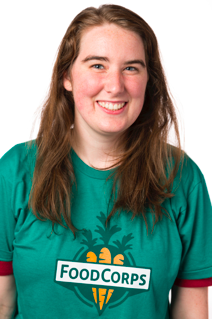My name is Marin Lissy, and I’m a ninth grader in Chapel Hill. I’ve been volunteering with Farmer Foodshare since I was in the sixth grade—I wrote a few blog posts (like this one) and even created a “kid-approved” cookbook as a Farmer Foodshare fundraiser.
Recently, I’ve started volunteering regularly at Farmer Foodshare’s Donation Station at the Chapel Hill Farmers Market. People often remark “You’re so young!” or ask me how old I am. While I guess it makes sense to me that they are surprised to see a young person volunteering, I wonder: why does it have to be that way? How can I change that?
BEYOND SERVICE HOURS
Why are people surprised to see young people volunteer? Teenagers are more often seen as being moody, self-centered, obsessed with their phones, and even trouble makers. Yikes! The truth is, though, that more and more young people are participating in community service.
According to the Corporation for National & Community Service, about 55% of youth ages 12-18 participate in some kind of volunteering activity. That’s almost twice the rate of American adults who volunteer (29%).
So, how can we increase these numbers for both youth and adults?
The main reason teenagers volunteer is in order to complete their volunteer hours requirement (25 hours are required for high school graduation in the state of North Carolina). Mandatory service hours are one way to encourage youth and teens to volunteer, but it shouldn’t just stop there. Engaging teens in service activities that cater to their interests and talents can have a positive impact and keep them occupied and productive.
WHY VOLUNTEER?
While I can’t say foodshare programs have always been my primary interest, but since I have been volunteering with Farmer Foodshare, I have grown to become quite fascinated with farming and bringing fresh food to “food deserts.” I also love to write, and writing blogs (like this one) for Farmer Foodshare is something that caters to what I enjoy.
Volunteering with Farmer Foodshare, for me, is a way to escape from thinking about myself, and exposes me to a lot of truths about the world: some people don’t have access to their next meal, especially a healthy meal. Meanwhile, farmers can struggle to sell their produce in order to make a living.
Connecting with other people and working together to solve problems can help lead everyone to develop a strong sense of community between farmers, people who need food, and the people who help bridge the gap.
It may sound cliche, but I’m always in a better mood after volunteering. I feel incredibly lucky to be able to contribute to people in my community. I would strongly encourage anyone to partake in some kind of community service, whether it be with Farmer Foodshare or another wonderful organization. And if you ever make it to the Chapel Hill Farmers Market on a Saturday morning, make sure to stop by the Donation Station and say hi!
A Marin’s-eye-view of the Chapel Hill Farmers Market from behind the Farmer Foodshare Donation Station table.









